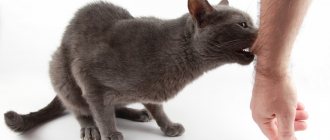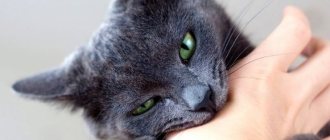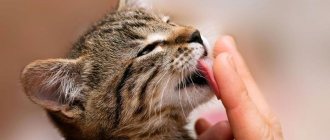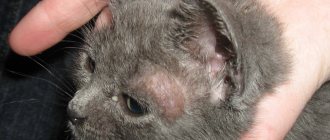Sometimes our cats do a little strange things that can leave us scratching our heads. One of those things is to sweetly lick your hands before you bite! What's up with this?
Some cats may bite you in a tiny, but painless way. Others bite to get an unforgettable experience, which is unpleasant. If your cat does the latter, it might be worth finding out more about why exactly they do it, and what you can do to stop them leaving teeth marks on your hand!
The cat is overly excited
Cats love to be petted, but sometimes a long petting session gets them over the edge. When this happens, our sweet and laid-back kitties may experience something called petting aggression.
It is thought to have something to do with the nerve endings connected to your cat's fur, and petting too often can cause discomfort. If your cat is gently licking you while you pet her and she suddenly bites you, this is probably the reason.
Image credit: congerdesign, Pixabay
Signs that a cat is overstimulated include widened eyes, folded ears, and tail flapping. Take the time to notice if your cat exhibits these signs when you pet her, and end the petting session before your cat reaches the point of overstimulation.
Some cats have areas of their fur that they can tolerate longer than others. By watching your cat's body language, you can make petting enjoyable for both of you.
The cat wants to rest
Cats love to play with their people and it's a great way to bond. However, they also have mood swings, and if you become overly persistent in playing and petting your pet, she will feel uncomfortable. Overstimulation occurs when a sensitive part of the body is touched accidentally and repeatedly. Your pet may lick and then gently bite you to show that he wants to take a break.
The cat is looking after you
If you watch how your cat grooms itself, you will see that it sometimes alternates between licking its fur and biting its skin. While for some cats this may be a standard part of their grooming routine, for others it may be a sign of a skin infection or irritation from flea bites, so make sure you know what is normal for your cat.
Cats that chew regularly as part of their grooming routine do the same to their owners! Your cat may not realize that this could harm you!
If your cat gets into the habit of biting you after you've cleaned her, start by gently removing your hand before she approaches the bite. You can distract them with a toy or treat to signal that their grooming is over.
Never scold a cat for biting you; after all, they don't necessarily understand what they did wrong. Remember that mutual grooming (including biting!) is a bonding behavior in cats. By proposing to you, your cat is letting you know that he considers you part of his social group. By offering to lick and groom you, they are trying to strengthen the bond between the two of you - which is quite cute!
How to understand when to take up parenting
Some owners are negligent about displays of aggression in their pets, even when they go beyond all limits. But what should a person do when everything is not so obvious? “Yes, the cat sometimes jumps out from around the corner and attacks the legs for no apparent reason, terrorizing the guests. This is the character of our furry animal.” Such an attitude, which at first seems to be a benevolent acceptance of a pet, upon closer examination turns out to be a manifestation of weakness and a subordinate position.
A biting kitten will sooner or later turn into a sharp-toothed big cat
It should be remembered that a cat is, first of all, a predator and he thinks of relationships with the inhabitants of the house in terms of hierarchy. This is especially true for uncastrated cats, which come into fighting condition in the spring. The fight for territory, for resources and for females who still do not come when called is a natural state for a cat, determined by instincts.
Therefore, if you want to see a fluffy ball next to you, consisting of tenderness and purring, then the only advice may be to buy a plush toy. Cats, like all other predators, are constantly fighting for survival, regardless of the conditions in which they find themselves. A certain amount of aggression towards the owner is normal - this is evidence that the cat is healthy and full of strength.
Unfortunately, angel cats who are ready to bring only joy to their owner have not been found in nature.
Since all cats are different, it is up to the owner to understand exactly where the pet crossed the border. There is no point in waiting for the moment when your furry pet turns into a tyrant and won’t let you take a step. In order not to resort to radical measures to calm an adult, it is advisable to educate her from a young age.
Education involves the cat’s perception of the owner’s message. The best place a person can take in relation to a cat is the place of leader of the pack. The leader must be fair and consistent, and his word, in turn, must be law.
If the cat understands in time that you are the “main” in this house, it will be easier to establish mutual understanding with him
Of course, cats are less likely to find their place in the pack compared to the same dogs. Representatives of cats are usually classified as “individualists”. However, your pet must learn that he is in a subordinate position, otherwise frequent showdowns cannot be avoided. If you manage to establish a relationship with a cat at this level, then even the most stubborn and grumpy four-legged friends will not need slippers and newspapers.
Stressed cat
Cats are sensitive creatures and sometimes they show stress by licking and biting. Some cats will groom themselves excessively, even pulling out fur. If your hand is near your cat, it may lick and then bite your hand.
Many things can cause stress in our cats, including moving to a new home, meeting a new pet, or being visited by strangers. If your cat is really nervous, talk to your veterinarian. Using a pheromone diffuser can also help calm your cat.
© shutterstock
Why does an animal bite and scratch?
Another way to convey your emotions and desires is to bite and scratch. This behavior is not always explainable to a person, and sometimes it seems to him that the cat bites for no reason, just like that.
But this is not so, such behavior always has a reason:
- It is not uncommon for an owner to give his pet a good beating for stealing a piece of sausage from the table: teach him a lesson with a broom or slipper, spank him with a towel, or throw him out into the street with a kick in the tail in the bitter cold of winter. Because, having received what he deserved, the cat will remember and will no longer misbehave. The cat will really remember and……. will take revenge. Therefore, when the owner has forgiven his fluffy cat and again tries to bestow affection on him, he may remember the offense;
- Sometimes the cat really wants to do something, but the owner doesn’t allow it. And then he shows stubbornness, biting and scratching;
- A kitten, like a child, can bite when it is teething;
- Cats often bite their kittens to show them their love. Such bites are weak and painless. If a cat slightly bites your hands, it is showing its love;
- Cats are predators by nature, but in a cozy human home there is always food, water and a warm sofa. Only the instincts still make themselves felt, and the energy requires an outlet. And then the cat plays, runs after a ray of sunlight and bites;
- During illness, a cat, like a person, can hardly enjoy any kind of affection; he just wants peace and relaxation.
The cat shows affection to you
It may not be your first choice, but small bites can be a sign of affection between cats. This is a normal behavioral interaction, especially between kittens. Some cats extend this same behavior to their owners!
If your cat is acting affectionate and then comes over to lick and bite, this is probably what is happening. Although there is no malicious intent behind it, sometimes you don't want to get bitten! In this case, pay attention to the cat's behavior before it approaches you and distract it before it gets to that point. You can still give and receive plenty of affection from your cat—just draw the line at love bites!
What can influence a pet's character?
Some physiological and psychological aspects can also affect the character of cats, changing their behavior and attitude towards the owner and his affection. Unexpected aggression, manifested for no apparent reason, can be provoked by:
- Puberty period. At this time, young cats behave like teenagers - aggressively, demonstratively. This is explained by hormonal surges and the emergence of new physiological needs. The solution here would be to find a mate for the pet or castration.
- Declawing is a major stressor for your pet. Feeling vulnerable and defenseless, a cat may try to defend itself with its teeth, even without visible potential danger.
- Lack of attention and care. Lack of communication and poor living conditions do not have the best effect on the psychological state of a pet. Therefore, it is worth finding about 15-20 minutes every day to play with your pet.
- Changing baby teeth to molars is accompanied by itching and unpleasant sensations in the gum area in kittens, which they try to eliminate with bites. Providing your pet with special toys designed for these purposes will help solve the issue.
Only by finding out the reasons for the strange behavior of your furry pet can you find the right options for its correction.
- how to trim a cat's claws;
- how to train a cat to use a scratching post.
Summarizing
Cats don't lick or bite without reason, so if your cat seems to behave this way regularly, then it's worth taking the time to find out why. If you think it's just affection or play, then you can either let them continue (if you don't mind getting your hand pinched) or find ways to distract your cat before she bites you.
If you think your cat's biting behavior is due to overstimulation, then it is important to make it clear to everyone in the house that petting should be kept short and to watch for signs of overstimulation in your cat. Petting-induced aggression is not your cat's fault; it is simply an automatic reaction to an unpleasant feeling. By paying attention to our cat's body language, we can ensure that we don't make her feel uncomfortable.
If you think your cat's biting behavior is related to stress, it is important to talk to your veterinarian and ask for advice on how to minimize it. Prolonged stress is harmful to cats and can lead to health problems.
If your cat ever licks and then bites you, do you understand why? What did you do to stop them? We'd love to hear from you!
Posted by Emma Stenhouse Emma is a freelance writer specializing in pets, outdoor activities and the environment. Originally from the UK, she lived in Costa Rica and New Zealand before moving to a small holding in Spain with her husband, their 4-year-old daughter and their dogs, cats, horses and birds.
Why is a cat bite always painful?
This is due to the structural features of cat teeth - one, and the bacterial flora of the animal's mouth - two.
The cat's dental system (30 teeth) has one peculiarity: every third molar of the upper and lower jaws, the largest, are fangs. The cat's fangs taper and flatten towards the end, and have the appearance of a Turkish dagger. The wounds inflicted by such a dagger are very deep and narrow, they heal faster than the blood flow can “push” out of the wound specific microorganisms (bacteria) that live in large numbers in the oral cavity of all living things.
Since the depth of a cat’s bite is a misleading concept due to its small size, these microorganisms cause inflammation and often suppuration of the wound.
Without antibiotics, it is difficult to treat such a puncture wound, especially if the bite occurred in a joint or deep underlying muscle and tendon tissue. It is necessary to distinguish whether the cat bit the finger into the soft tissue or touched the ligaments. Such a bite can lead to damage to the flexor-extensor apparatus, and the treatment of such damage can take a long time.
Such bites are dangerous not only for the fingers, they are also dangerous for the face and neck. For the face and décolleté there is also a purely cosmetic effect - poorly healing wounds lead to the formation of scars, which is especially unpleasant for women, especially if the bite was “seasoned” with deep scratches in the same area.
Reasons for unexpected aggression
Cats can bite in different ways. There are two options for this behavior:
- The rarest one is when the pet gently bites its fingers, while the claws are removed and its actions are more pleasant than not. This is what they do most often when communicating with their offspring. When a cat behaves like this with its owner, it means it trusts him and loves him very much.
- More common is a sudden change in behavior. A second ago, the pet took the stroking absolutely calmly, showing no signs of aggression, but now it turned over and began to painfully bite and scratch the hand.
It is important to understand the reasons that motivate cats to bite and scratch their owner's hands. Among the most common are:
Aggression
Often a sign of problems with the pet's socialization. Breeders try to accustom a kitten to stroking in early childhood - up to 7 weeks of age. If this is not done, then in adulthood such an animal will shy away from affection from its owners and bite.
Pain
It is important to remember that cats, like people, are not always healthy; they have stomach, back, head, joint pain, and may have skin problems. Therefore, when showing affection, when something is not right with their health, they can bite. By this they are trying to tell the owner to leave them alone.
If behavior that is not typical appears, you should contact a veterinary clinic for examination, as this may be an indirect sign of illness.
Static electricity
Often, if the animal's fur is too dry and the air humidity is high, microdischarges may form when stroking. A person may not notice this, but it is extremely unpleasant for a pet, so he may bite.
Pet gender
This factor also needs to be taken into account. Many cats are more affectionate, but can be aggressive once they become mothers. Cats are often independent and do not like excessive affection, with the exception of castrated individuals; they begin to show more attention to the owner and demand the same from him.
Increased attention from a person
It must be remembered that these are independent animals that do not like being forced on them. The exception is Oriental cat breeds. Such pets are extremely sociable and loving. But they can also be in a bad mood when affection does not bring pleasure.
Dream
Some cats fall asleep during stroking and, if the rhythm or pressure changes, they may wake up and bite. This behavior is common among poorly socialized pets who always expect trickery from people. Or another situation - the animal is sleeping so soundly that stroking came as a surprise and frightened it. In this case, it is simply a defensive reaction against fear.
Dominant behavior
The cat thus tries to establish himself and show that he is the boss in the house. He tries to control the process of affection on the part of the owner.
Negative experiences in the past
Often people pet their pets before unpleasant procedures, such as nail trimming or bathing. But for them the model is fixed: if they stroked it, something unpleasant happened. And subsequent displays of affection on the part of the owner will provoke biting and scratching.
Early weaning
Cats teach their offspring that a person is a friend, he feeds, caresses and does not cause pain. If you take the kittens away from her too early, they won't recognize it and may perceive people negatively. Pets raised on the street also display a similar pattern of behavior. Cats do not know that their owners are trying to show their love and care in this way, but consider affection a threat to themselves.
Feeding kittens and pregnancy
During this period, some cats may experience a change in character, and in this way they try to protect their offspring and protect them.
The Art of Hunting
Don’t let it come as a surprise to you when your pet begins to teach her offspring to hunt. At the beginning of classes it will look something like this: the mother cat firmly grabs the kitten with her front paws and beats on him with her hind paws. At the same time, she alternates between biting and licking him. In addition, it can purr loudly, encouraging it to learn.
1:2033
At the initial stage of training in the art of hunting, the cat demonstrates with its kittens how to properly capture and subdue the prey. In addition, the ability to suppress will be needed by the young when they grow up and begin to defend their rights to territory and dominance. And believe me, in a couple of weeks you will already be watching kids practicing these techniques on each other.
1:666
2:1170
When the litter grows a little more and begins to crawl out of the shelter, a slightly different picture will open before you. In addition to the training activities described above, demonstration hunting jumps and pursuit will be added. Mommy, by personal example, will show the children how to sneak, wait and suddenly jump on the victim. Everything will remain the same with the squeak: if you meow, you understand. As before, the young animals will continue to practice the techniques both among themselves and on the mother.
2:1993
Cat bites kitten.Cat bites kitten
Single-breed Maine Coon nursery “Moon Cat” Saint Petersburg, Russia We are located a fifteen-minute walk from the metro station...
Childbirth is quite stressful for cats, as it is for absolutely any woman giving birth. Often, cat psychology, already poorly understood by people, changes significantly after the birth of offspring. You can often observe how a pet bites its babies, hits them with its hind legs or drags them by the scruff of the neck, while the kittens squeak.
The owners, alarmed by this behavior of their pet, begin to sound the alarm. However, not every mother cat nibbling on her litter is a danger signal. In this article we will try to understand when the behavior of a new mother is within the normal range, and when it is worth worrying about.
A cat who has become a mother faces a difficult task: she needs to teach her litter everything she knows in the shortest possible time. This is required so that the kittens are ready for independent living. Moreover, in the wild, such activities would ensure their survival. At the same time, cats have much less time at their disposal than people have to raise their children.
You don't have to worry if your pet bites the kittens without leaving marks on their skins. As a rule, educational biting lasts until the baby makes a loud cry. With his voice, he lets his mother know that he understands everything, and, satisfied with this signal, she lets him go.
The psychology of the cat family is radically different from that of humans, and yet, in some ways we are similar. These animals, just like people, have their own methods of raising and protecting babies from danger.
Where a human mother would slap a naughty fidget on the butt, a cat mother will in the same way tell her baby how not to behave by biting the scruff of the neck. She can punish the kitten if it gets too excited and runs around, ceasing to notice everything around it. And also if the baby, being in a playful mood, climbs up to her, and in the meantime she tries to take a nap and replenish her strength.
A cat is capable of biting the skin of kittens that are trying to get out of the nest if she thinks that it is too early for them to do this. She will definitely claw her by the scruff of the neck or even hiss threateningly, not letting her onto the balcony, which, in her opinion, can be dangerous for furry fidgets.
You don’t have to worry if you notice how the mother stands over the baby and then takes his scruff in her mouth, then lets go. There is a high probability that at this moment she is not trying to harm him, but, on the contrary, wants to move him to a safe place. She just can't do it for some reason. Probably, the pet cannot figure out how best to lift it so as not to harm it. This sometimes happens, however, after several attempts, as a rule, the cat copes with the task.
Don’t let it come as a surprise to you when your pet begins to teach her offspring to hunt. At the beginning of classes it will look something like this: the mother cat firmly grabs the kitten with her front paws and beats on him with her hind paws. At the same time, she alternates between biting and licking him. In addition, it can purr loudly, encouraging it to learn.
At the initial stage of training in the art of hunting, the cat demonstrates with its kittens how to properly capture and subdue the prey. In addition, the ability to suppress will be needed by the young when they grow up and begin to defend their rights to territory and dominance. And believe me, in a couple of weeks you will already be watching kids practicing these techniques on each other.
When the litter grows a little more and begins to crawl out of the shelter, a slightly different picture will open before you. In addition to the training activities described above, demonstration hunting jumps and pursuit will be added. Mommy, by personal example, will show the children how to sneak, wait and suddenly jump on the victim. Everything will remain the same with the squeak: if you meow, you understand. As before, the young animals will continue to practice the techniques both among themselves and on the mother.
Some particularly intelligent individuals independently teach their children to relieve themselves in a specially designated place. Mother cat, when the babies are old enough, will show them where the tray is located and what to do with it. The most clueless kittens may also be bitten or hit by a paw.
From the outside, the behavior of your pets will really look like a game between mother and kittens with elements of lightly biting each other. However, there is also a feline subtext here. In fact, by biting the offspring on different parts of the body, the cat tests their reflexes and at the same time provides an incentive for greater activity. Babies are still developing physically, so to strengthen their muscles they need to move a lot, which their mother helps with.
As a rule, it is not difficult to detect real aggression in a pet’s behavioral line. While playing and teaching, she controls her every action, is gentle and caring, and licks the cubs. However, if she leaves marks of claws and teeth on the kittens’ skins, constantly hisses and kicks them threateningly, and an unhealthy shine is noticeable in the eyes - this is aggression in its purest form.
In the case where a cat bites its offspring, and at the same time was previously picked up on the street or has access there for walks, this is a very bad sign. The fact is that such animals always remain semi-wild and their natural instincts are more acute than those of fully domesticated pets. Here, the reason for aggression towards one’s own offspring can be a foreign smell on the kittens.
There are times when a pet suddenly begins to show excessive aggression both towards its own babies and towards its owners. It is not uncommon for cats to develop eclampsia after giving birth, and this can be a reason for sudden hostility.
Eclampsia is a disease that should only be diagnosed by a specialist. It is not recommended to make a diagnosis yourself, because the cause of aggressive behavior may be simple fatigue or pain in the mammary glands (mastopathy). And yet, given that this disease occurs quite often, let's talk about it in more detail.
Eclampsia (aka milk fever) is provoked by hypocalcemia - a disorder of calcium metabolism in the body, in which it begins to be sorely lacking. Milk fever usually develops in the first 2–3 weeks after lambing. This is due to the active leaching of calcium from the blood, due to the fact that it is involved in the formation of milk. Most common in mothers with multiple births.
Childbirth is as stressful for a cat as it is for any woman. Cats, whose psychology is not very clear to humans, usually change greatly after giving birth, and sometimes show extreme aggression towards their own kittens and towards their owners.
Often after giving birth, a cat bites kittens, and quite aggressively, using teeth and claws. If the new mother only touches the fur of the kittens with her teeth, there is no need to worry, perhaps this is how she is trying to protect them from danger. The alarm should be sounded if there is a clear aggressive overtone in the pet’s behavior.
For what reasons do cats begin to show aggression towards their own newborn children, biting them? Most often, the essence of the problem lies in the development of eclampsia. This disease is often found in cats that have recently given birth and is dangerous because the animals’ calcium levels in the body decrease. Since a cat constantly feeds her babies with milk, she needs to maintain a decent level of calcium in her body, otherwise her behavior will begin to change.
In this case, the animal should be shown to a specialist who will prescribe a course of calcium for the new mother. Usually, calcium injections help quickly restore the cat’s normal well-being. If you do not show the animal to a specialist on time, eclampsia can cause death.
Often, a cat bites its newborn babies because it is trying to raise them. Here the owner should carefully monitor the pet, controlling its level of aggression. If a cat only lightly touches the babies without harming them, then she is trying to teach them something. Perhaps the kids are too actively disturbing their mother, and thus she carries out educational work with them.
If a cat shows excessive aggression towards her babies, the owner should isolate the kittens so that they are not harmed. If the bites are mild in nature and serve as a subject of play or an element of education, there is no need to worry and isolate newborns.
Why does a cat bite its kittens is a question that arises for many owners. Often the reason lies in a simple game between a mother and her children. Sometimes a cat slightly bites her babies, and they respond with reciprocal actions. This behavior is sometimes caused by the fact that babies begin to cut their teeth and bite everything, and the mother simply supports this game.
It is usually not difficult to identify genuine aggression in a cat’s behavior. If she plays or teaches her babies through a bite, she does it carefully, with the tenderness inherent in every mother. If a cat wants to cause damage to its offspring, the owners will definitely notice this.
Do not forget that pets have a completely different psychology than people. That is why, if a cat sees that one of her babies is too weak, eats little and is sick a lot, she may try to kill him, including through bites. If a cat bites her baby hard until it bleeds, showing aggression and kicking him with her paws, the kitten should be immediately isolated. Usually such strong aggressiveness manifests itself only towards one baby, and the mother carefully protects the rest.
How to recognize readiness for an attack
Cats do not bite without warning; it is important to pay attention to the signs before attacking. These include:
- the animal's posture changes;
- the pet’s body tenses, which can be felt when touched;
- the purring suddenly stops;
- ears flatten;
- anger in the gaze, pupils dilate;
- the nature of the sounds produced becomes threatening, for example, rumbling, purring;
- the expression of the muzzle changes from peaceful to angry;
- the tail begins to twitch.
One or a combination of signs indicate that the pet is aggressive, that it has begun to get angry and that it will soon attack a person. You should not ignore them, but it is better to leave the cat alone for a while so that he calms down.
Common signs of stress in dogs
- Frequent yawning by your pet when you are sure that he has had enough sleep.
- Hair loss (a common symptom with cats).
- Loss of appetite/overeating (common with cats).
- Chewing/licking front paws.
- “Whale eye” (a common feature with cats).
- Licking lips and nose (common with cats).
- Unreasonable barking or whining.
- Shaking or pinching the tail between the paws.
- Chaotic movements back and forth.
Tags
Petya Koshkin Why a cat first How cats express Why a cat licks another cat. Cat bites demonstrate Why a cat Why a cat Why cats Why mine licks. Why cat Why cats Why cats purpose. Why is this so wrong? Why a cat Why do cats or cat characters and Caring cats play How cats become attached Hermitage cats play cats or cat characters and Caring cats How cats become attached Hermitage cats
affectionateattentionlickscatbreedcandogpetresponseprocessownerhelpsignshealth










